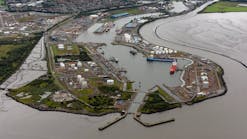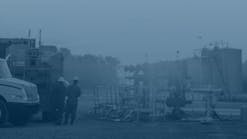Despite a regional economic crisis that has dampened demand for petroleum, South Korea's Korea Gas Corp. (Kogas) is proceeding with plans to import LNG from Qatar beginning in 1999 (see related story, p. 33).
The Asian crisis has cast doubt on Kogas's ability to meet its contractual obligations with Qatar's Ras Laffan Liquefied Natural Gas Co. (RasGas), says Standard & Poor's (S&P), New York. But S&P believes South Korea's financial woes will not materially alter the planned start-up of the RasGas liquefaction plant and LNG terminal (OGJ, Mar. 16, 1998, Newsletter).
The more important variable for RasGas is how Asia's economic crisis will affect South Korea's demand for LNG, says S&P.
Kogas is the only company under contract to take LNG from the venture (OGJ, Feb. 24, 1997, p. 49). Kogas agreed to begin purchasing 600,000 metric tons/year of LNG when RasGas's liquefaction plant starts up.
Output from the RasGas plant is expected to ramp up to 4.8 million metric tons/year by 2003.
Increased risk
S&P said, "Given that these Korea-source LNG revenues will account for about 75% of the project's revenue base, project cash flows post-construction are more at risk than when Standard & Poor's originally assigned its triple-B-plus/stable rating to the (RasGas) bonds."Standard & Poor's is evaluating the counterparty risk that Kogas presents to Ras Laffan and its lenders. This analysis is focusing on the status of LNG infrastructure construction in Korea, the potential for merchant LNG sales, revised Korean energy consumption forecasts, and potential addition sponsor support of the project."
"While the analysis is continuing," said S&P, "(we have) concluded preliminarily that much of the Korean infrastructure support does not present a significant risk."
The analyst said South Korea had made significant progress in preparing to receive LNG imports from RasGas. South Korea's second LNG terminal at Inchon was completed last year and is operational. New storage tanks being built at Pyongtaek should be completed this year. And more than 1,300 km of a finished natural gas trunk line is in operation.
"No evidence indicates that construction progress is at risk," said S&P.
South Korea also is constructing seven new LNG carriers in preparation for start-up of the RasGas plant. Construction of the ships is "largely on schedule," said S&P, "and should not interfere with the Ras Laffan start-up date.
"Should a material delay occur in the delivery of newbuild ships, existing LNG ships are available for Kogas use."
South Korean LNG demand
If Kogas is not able to meet its contract obligations, RasGas will have difficulty finding alternative customers for the excess LNG, says S&P."The greater unknown for Ras Laffan is whether and how the Korean economic crisis will affect LNG consumption in Korea," said the analyst. "LNG demand from Kepco (Korea Electric Power Corp.) will be more sensitive to an economic downturn than non-electric generating consumption."
Electricity generation accounts for about 50% of South Korea's LNG demand.
Kepco expects to add about 2,900 MW of LNG-fired generating capacity in 1998, said S&P, plus another 450 MW in 1999 and 2,000 MW by 2005. This should bolster South Korea's LNG demand, thus mitigating RasGas's risk.
"Kepco and the government remain committed to using LNG for diversity of supply and environmental reasons," said the analyst. The firm warned, however, that, "the government will be releasing new energy and economic forecasts...that could result in negative revisions to (the outlook for LNG demand).
"At that time, Standard & Poor's will update its position and analysis of the effects of the Korean financial crisis on the Ras Laffan project. Should the forecast indicate a significant decrease in demand for several years or more-over 25% of the current forecast-a downgrade to noninvestment grade could occur."
Progress in Qatar
S&P's outlook remains somewhat positive, however: "Construction progress on the offshore production facilities, the pipelines, and the onshore facilities in Qatar are largely ahead of schedule and remain unaffected by events in Korea."The pipelines are 63% complete, Offshore Train 1 is 70% complete, Offshore Train 2 is 30% complete, Onshore Train 1 is 72% complete, and Onshore Train 2 is 41% complete.
The project sponsors have guaranteed that the bonds will be repaid if the project is unable to start up on time. "The combination of capitalized interest and completion guarantees completely protects lenders for at least the next 36 months," said S&P.
The firm recently upgraded its rating of South Korea's currency. "The upgrade of the ratings on the Republic of Korea reflects the progress that the outgoing administration of Kim Young-Sam, working in close cooperation with the incoming administration of Kim Dae-Jung, has made in implementing reforms on labor flexibility, corporate restructuring, foreign ownership, and bankruptcy."
Copyright 1998 Oil & Gas Journal. All Rights Reserved.


